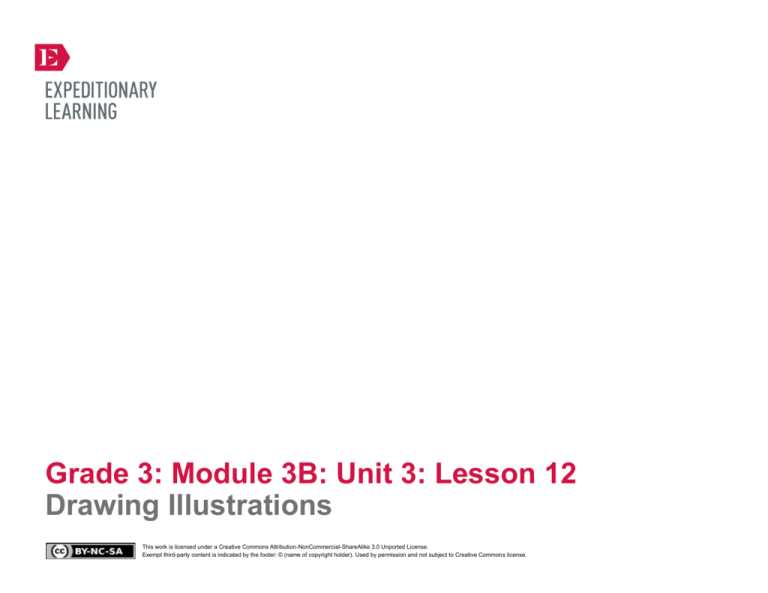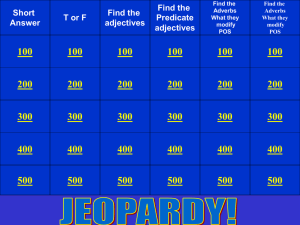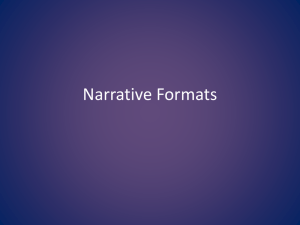
Grade 3: Module 3B: Unit 3: Lesson 12
Drawing Illustrations
This work is licensed under a Creative Commons Attribution-NonCommercial-ShareAlike 3.0 Unported License.
Exempt third-party content is indicated by the footer: © (name of copyright holder). Used by permission and not subject to Creative Commons license.
GRADE 3: MODULE 3B: UNIT 3: LESSON 12
Drawing Illustrations
Long-Term Targets Addressed (Based on NYSP12 ELA CCLS)
I can demonstrate command of the conventions of standard English grammar and usage when writing or speaking. (L.3.1)
I can form and use comparative and superlative adjectives and adverbs, and choose between them depending on what is to be modified. (L.3.1g)
I can explain how an illustration contributes to the story (e.g., mood, tone, character, setting). (RL.3.7)
Supporting Learning Targets
Ongoing Assessment
• I can use adjectives to describe nouns in my Wolf Narrative.
• Three illustrations for Wolf Narrative
• I can use adverbs to describe actions in my Wolf Narrative.
• I can illustrate my Wolf Narrative and explain how the illustrations contribute to my narrative.
Created by Expeditionary Learning, on behalf of Public Consulting Group, Inc.
© Public Consulting Group, Inc., with a perpetual license granted to Expeditionary Learning Outward Bound, Inc.
NYS Common Core ELA Curriculum • G3:M3B:U3:L12 • June 2014 • 1
GRADE 3: MODULE 3B: UNIT 3: LESSON 12
Drawing Illustrations
Agenda
Teaching Notes
1. Opening
• To address language standard L.3.1g, students add some adverbs and adjectives to their writing in this
lesson. Since the standard is listed as criteria on the Narrative Writing Rubric, students begin there to
give the revisions process a purpose. Students do not rewrite their drafts; instead, they add words in the
margin of the paper with stars showing where they will go.
A. Unpacking Learning Targets (5 minutes)
2. Work Time
A. Analyzing the Wolf Narrative Model: Adjectives and
Adverbs (20 minutes)
B. Creating Illustrations for the Wolf Narrative (30
minutes)
3. Closing and Assessment
A. Adding to the Criteria of a Strong Narrative Anchor
Chart (5 minutes)
4. Homework
A. If you didn’t finish your illustrations in class, finish
them at home.
B. Continue reading your independent reading book.
• Students also begin to create illustrations for their Wolf Narratives. You can determine which medium
students will use depending on your resources. If students are publishing their narratives using the
computer, you may wish to have them use art software to create the illustrations on the computer as
well. You may want to work with a technology teacher on this project. Other options include paints,
pastels, sketching, etc. It may also be a good idea to collaborate with an art teacher on this project.
• If students are using a medium for creating their illustrations that they cannot take home, they may
require additional class time to complete their illustrations.
• Some students many need more time than what is allocated in this lesson to finish their illustrations.
Depending on the resources they are using, these students may be able to finish for homework.
• Be prepared to return students’ End of Unit 3 Assessments: Drafting the Wolf Narrative with feedback
at the beginning of the next lesson.
• In advance:
– Prepare the resources students will need to complete their illustrations.
– Post: Learning targets; Criteria of a Strong Narrative anchor chart.
Created by Expeditionary Learning, on behalf of Public Consulting Group, Inc.
© Public Consulting Group, Inc., with a perpetual license granted to Expeditionary Learning Outward Bound, Inc.
NYS Common Core ELA Curriculum • G3:M3B:U3:L12 • June 2014 • 2
GRADE 3: MODULE 3B: UNIT 3: LESSON 12
Drawing Illustrations
Lesson Vocabulary
Materials
adjective, noun, adverb, illustrate
• Narrative Writing Rubric (from Lesson 1; one to display)
• Dictionaries (one per pair)
• Wolf Narrative model (from Unit 2, Lesson 1; one per student)
• Adjective, Noun, Adverb, and Action note-catcher (one per student and one to display)
• Adjective, Noun, Adverb, and Action note-catcher (answers, for teacher reference)
• Revised Wolf Narratives (from Lesson 11; students’ own)
• Highlighters (two different colors per student)
• Criteria of a Strong Narrative anchor chart (begun in Lesson 1)
• Illustration Planning graphic organizer (from Lesson 8; one per student)
• Blank paper (three pieces per student)
• Art supplies (enough for all students; see Teaching Notes)
• Face to Face with Wolves (book; one per student)
Created by Expeditionary Learning, on behalf of Public Consulting Group, Inc.
© Public Consulting Group, Inc., with a perpetual license granted to Expeditionary Learning Outward Bound, Inc.
NYS Common Core ELA Curriculum • G3:M3B:U3:L12 • June 2014 • 3
GRADE 3: MODULE 3B: UNIT 3: LESSON 12
Drawing Illustrations
Opening
Meeting Students’ Needs
A. Unpacking Learning Targets (5 minutes)
• Direct students’ attention to the posted learning targets and read the first two aloud:
• Posting learning targets allows
students to reference them
throughout the lesson to check their
understanding. The learning targets
also provide a reminder to students
and teachers about the intended
learning behind a given lesson or
activity.
* “I can use adjectives to describe nouns in my Wolf Narrative.”
* “I can use adverbs to describe actions in my Wolf Narrative.”
• Display the Narrative Writing Rubric.
• Point out that these learning targets are criteria listed in the Conventions section on the rubric. Tell students that many of
the words in these learning targets may be unfamiliar at the moment, but in this lesson they approach the learning targets
one at a time to learn more about what they mean, analyze the Wolf Narrative model, and then add some adjectives and
adverbs to their Wolf Narrative drafts.
• Direct students’ attention back to the posted learning targets and read the final one aloud:
* “I can illustrate my Wolf Narrative and explain how the illustrations contribute to my narrative.”
• Ask students to discuss with an elbow partner:
* “What does illustrate mean?”
• Select volunteers to share their responses. Listen for students to explain that illustrate has two meanings. Illustrate can
mean draw pictures to accompany text or a story, like the illustrations in a book. Illustrate also means to explain or make
clear.
• Remind students that illustrations in a story are not just pictures—they are pictures that give the reader extra clues or
emphasize something that the author wants us to understand.
Created by Expeditionary Learning, on behalf of Public Consulting Group, Inc.
© Public Consulting Group, Inc., with a perpetual license granted to Expeditionary Learning Outward Bound, Inc.
NYS Common Core ELA Curriculum • G3:M3B:U3:L12 • June 2014 • 4
GRADE 3: MODULE 3B: UNIT 3: LESSON 12
Drawing Illustrations
Work Time
Meeting Students’ Needs
A. Analyzing the Wolf Narrative Model: Adjectives and Adverbs (20 minutes)
• Distribute dictionaries.
• Asking students to identify
examples of adjectives and adverbs
in the model narrative will help
them to understand how those
words have been used to paint a
clearer picture for the reader, which
they can then apply to their own
work.
• Remind students of the first two learning targets:
* “I can use adjectives to describe nouns in my Wolf Narrative.”
* “I can use adverbs to describe actions in my Wolf Narrative.”
• Ask students to discuss with an elbow partner, using a dictionary if they need to:
* “What is an adjective?”
• Cold call students. Listen for and guide students to understand that an adjective is a describing word.
• Suggest an example: the enormous pizza. Ask students to discuss with their partners:
* “What is the describing word?”
• Select volunteers to share their responses. Listen for students to explain that “enormous” is the describing word—it
describes the size of the pizza.
• Ask students to discuss with an elbow partner, using a dictionary if they need to:
* “What is a noun?”
• Select volunteers to share their responses. Listen for and guide students to understand that a noun is the name of a thing or
a person. For example, pencil, Jill, hand, etc.
• Return to the example: the enormous pizza. Ask students to discuss with their partners:
* “So what is the noun?”
• Cold call students to share their responses. Listen for and guide students to understand that “pizza” is the noun. Pizza is the
name of the thing being described.
• Pair students up and invite them to retrieve their Wolf Narrative models.
• Display and distribute the Adjective, Noun, Adverb, and Action note-catcher.
• Model how to fill in the Adjective and Noun columns using the first paragraph of the Wolf Narrative model. Refer to the
Adjective, Noun, Adverb, and Action note-catcher (answers, for teacher reference) as a guide.
Created by Expeditionary Learning, on behalf of Public Consulting Group, Inc.
© Public Consulting Group, Inc., with a perpetual license granted to Expeditionary Learning Outward Bound, Inc.
NYS Common Core ELA Curriculum • G3:M3B:U3:L12 • June 2014 • 5
GRADE 3: MODULE 3B: UNIT 3: LESSON 12
Drawing Illustrations
Meeting Students’ Needs
Work Time (continued)
• Tell students they are going to work in pairs to whisper read the next two paragraphs (Paragraphs 2 and 3) and record any
adjectives they find and the nouns they describe on their note-catchers.
• Circulate to support students. Ask guiding questions:
* “What is the noun here?”
* “And what is the adjective describing it?”
• Refocus whole group. Ask for volunteers to share the adjectives they found and the nouns they describe with the whole
group.
• Ask students to discuss with an elbow partner, using a dictionary if they need to:
* “What is an adverb?”
• Cold call students. Listen for and guide students to understand that an adverb is a word that describes how a verb, a doing
word, is done.
• Suggest an example: He walked quietly. Ask students to discuss with their partners:
* “What is the adverb?”
• Select volunteers to share their responses. Listen for students to explain that “quietly” is the adverb—it describes how he
walked. Emphasize here that a good way to spot an adverb is that it often has “-ly” at the end, for example: noisily, dreamily,
angrily, and heavily.
• Explain to students that an action is what the character is doing
• Return to the example: He walked quietly. Ask students to discuss with an elbow partner:
* “So what is the action here?”
• Cold call students to share their responses. Listen for and guide students to understand that “walked” is the action that is
being described.
• Model how to fill in the Adverb and Action columns using the first paragraph of the Wolf Narrative model. Refer to the
Adjective, Noun, Adverb, and Action note-catcher (answers, for teacher reference) as a guide.
• Invite students to work with their partners to do the same for the next two paragraphs of the Wolf Narrative model
(Paragraphs 2 and 3).
Created by Expeditionary Learning, on behalf of Public Consulting Group, Inc.
© Public Consulting Group, Inc., with a perpetual license granted to Expeditionary Learning Outward Bound, Inc.
NYS Common Core ELA Curriculum • G3:M3B:U3:L12 • June 2014 • 6
GRADE 3: MODULE 3B: UNIT 3: LESSON 12
Drawing Illustrations
Meeting Students’ Needs
Work Time (continued)
• Circulate to support students. Ask guiding questions:
* “What is the action here?”
* “And what is the adverb describing it?”
• Refocus whole group. Ask students to share the adverbs they found and the actions they describe with the whole group.
• Ask students to discuss with an elbow partner:
* “What do you notice about adjectives and adverbs? What do they do to a narrative?”
• Select volunteers to share their ideas with the whole group. Listen for students to explain that adjectives and adverbs help to
paint a picture of what things look like and how actions were done. For example, “He stretched sleepily,” rather than just,
“He stretched,” gives us a clearer idea of how he did it.
• Invite students to retrieve their revised Wolf Narratives from Lesson 11.
• Distribute highlighters.
• Invite students to read through their Wolf Narratives twice. During the first read, they should use one color to highlight the
adjectives that describe nouns. During the second read, they should use the other color to highlight the adverbs describing
actions. Explain that the aim of this exercise is for students to quickly see how many adjectives and adverbs they have used.
• As students begin to finish, refocus whole group and explain that highlighting should have revealed gaps where they are
missing either adverbs or adjectives or both.
• Tell students that they are going to add two more adverbs to describe actions and two more adjectives to describe nouns to
their writing. Explain that rather than rewriting their narratives, they should just draw a star where they want to add a word,
and write the word in the margin of that line.
• Identify a student who clearly has a number of gaps that could be filled and display his or her work as you model the process
for all students to see.
• Circulate to support students. Ask guiding questions:
* “Why does this noun need an adjective?”
* “Why does this action need an adverb?”
• “Is an adjective/adverb really necessary here?”
Created by Expeditionary Learning, on behalf of Public Consulting Group, Inc.
© Public Consulting Group, Inc., with a perpetual license granted to Expeditionary Learning Outward Bound, Inc.
NYS Common Core ELA Curriculum • G3:M3B:U3:L12 • June 2014 • 7
GRADE 3: MODULE 3B: UNIT 3: LESSON 12
Drawing Illustrations
Work Time (continued)
Meeting Students’ Needs
B. Creating Illustrations for the Wolf Narrative (30 minutes)
• Tell students that now they are going to complete the illustrations for their Wolf Narratives, and that in the next lesson they
are going to put their writing and illustrations together to make their final narrative.
• Consider working with other faculty,
for example art or technology
teachers, as appropriate to support
struggling students in using the
medium you have selected.
• Focus students’ attention on the Criteria of a Strong Narrative anchor chart and point out the illustration criteria.
• Ask students to follow along silently as you read it aloud.
• Invite students to take out their most recent Illustration Planning graphic organizers and revised Wolf Narratives.
• Give students 5 minutes to silently look at the plans of their illustrations and their revised narratives to check that the
illustrations they have planned still work with the content of their narratives. If they do not, ask students to reconsider what
their illustrations need to be instead. Again, remind students that illustrations in a story are not just pictures—they are
pictures that give the reader extra clues or emphasize something the author wants us to understand.
• Refocus whole group.
• Distribute blank paper and any other necessary art supplies. Explain that students will use one piece of paper for each
illustration.
• Ensure that students have access to Face to Face with Wolves.
• Remind students that their narratives are about real wolves, so the wolves in their illustrations should look like real wolves.
• Circulate to support students as they work. Ask guiding questions:
* “What does this show?”
* “What is going on in this picture?”
* “How does it add meaning to your story?”
* “What mood does it create?”
Created by Expeditionary Learning, on behalf of Public Consulting Group, Inc.
© Public Consulting Group, Inc., with a perpetual license granted to Expeditionary Learning Outward Bound, Inc.
NYS Common Core ELA Curriculum • G3:M3B:U3:L12 • June 2014 • 8
GRADE 3: MODULE 3B: UNIT 3: LESSON 12
Drawing Illustrations
Closing and Assessment
Meeting Students’ Needs
A. Adding to the Criteria of a Strong Narrative Anchor Chart (5 minutes)
• Focus students’ attention on the Criteria of a Strong Narrative anchor chart.
• Adding new learning to the anchor
chart for future reference will
support struggling learners when
they write their final drafts,
providing a clear list of criteria
reflecting their learning process to
refer to.
• Ask students to discuss in pairs:
* “What do we need to add to the anchor chart based on your learning today?”
• Select volunteers to share their responses. Listen for them to list the learning targets.
• Record the following on the anchor chart: “Includes adjectives to describe nouns” and “Includes adverbs to describe
actions.”
Homework
Meeting Students’ Needs
• If you didn’t finish your illustrations in class, finish them.
• Continue reading your independent reading book.
Created by Expeditionary Learning, on behalf of Public Consulting Group, Inc.
© Public Consulting Group, Inc., with a perpetual license granted to Expeditionary Learning Outward Bound, Inc.
NYS Common Core ELA Curriculum • G3:M3B:U3:L12 • June 2014 • 9
Grade 3: Module 3B: Unit 2: Lesson 12
Supporting Materials
This work is licensed under a Creative Commons Attribution-NonCommercial-ShareAlike 3.0 Unported License.
Exempt third-party content is indicated by the footer: © (name of copyright holder). Used by permission and not subject to Creative Commons license.
GRADE 3: MODULE 3B: UNIT 3: LESSON 12
Adjective, Noun, Adverb, and Action Note-catcher
Name:
Date:
Learning Targets:
I can use adjectives to describe nouns in my Wolf Narrative.
I can use adverbs to describe actions in my Wolf Narrative.
Adjectives
Nouns
Copyright © 2013 by Expeditionary Learning, New York, NY. All Rights Reserved
Adverbs
Actions
NYS Common Core ELA Curriculum • G3:M3B:U3:L12 • June 2014 • 11
GRADE 3: MODULE 3B: UNIT 3: LESSON 12
Adjective, Noun, Adverb, and Action Note-catcher
Answers For Teacher Reference
Adjectives
Nouns
Adverbs
Actions
eerie
shadows
sleepily
stretched
small
feet
slowly
got up
good
meal
affectionately
licked
solemnly
addressed
weakly
whined
Copyright © 2013 by Expeditionary Learning, New York, NY. All Rights Reserved
NYS Common Core ELA Curriculum • G3:M3B:U3:L12 • June 2014 • 12









